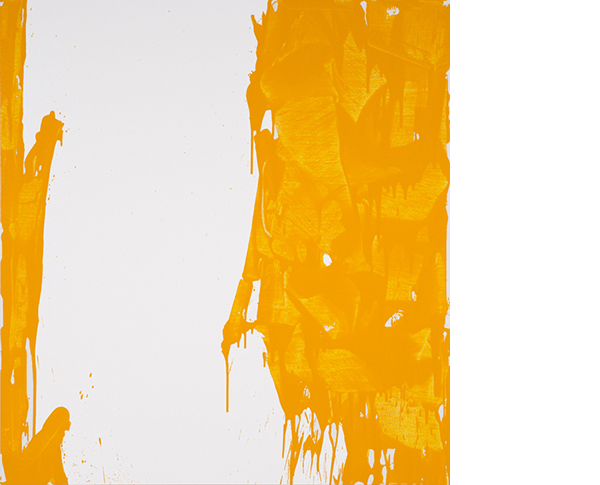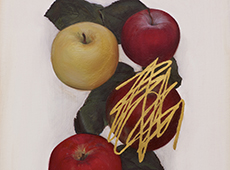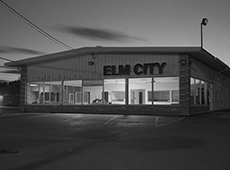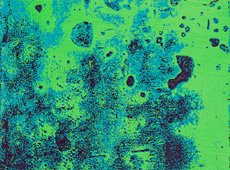What was it that launched our own painting out of the issues of abstract expressionism? For me, it always means making paintings that are event-driven, something where you’re looking for an image that will emerge out of the painting process itself.
A discussion of Re-Irascibles: Theodoros Stamos and John Zinsser, an exhibition at Graham Gallery in New York. Stamos (1922-1997) was the youngest of the group of New York abstract expressionists who came to be called “The Irascibles.” Zinsser (b. 1961) is a painter and writer known for his interest in post-war American abstraction. A survey of selected significant historical Stamos works is paired against new paintings by Zinsser that respond directly to Stamos’ imagery and methodologies. Interviewer Guy C. Corriero is a painter and ceramics sculptor. Both artists have studios in Greenpoint, Brooklyn, a neighborhood proximity that has led to years of ongoing art discussions between the two. This interview was conducted on March 17, 2015.
![]()
GUY C. CORRIEROHow did the show come about?
JOHN ZINSSER A year ago, Graham Gallery asked me if I would want to do a show pairing me with a historical artist; because they’re a gallery [founded in 1857] that does American painting and sculpture, historical along with a contemporary program.
I was working on this with Abby Taylor, who already had a strong interest in Stamos, so he seemed like a natural candidate, given my interests. We were able to track down some very good original material in New York. So that was amazing, to be able to use real paintings from the abstract expressionist era to work with. That, and the fact that Stamos is a kind of shadowy, under-known figure of that period made it compelling as a story to tell.
“But this was more like, what happens if you actually go so far as to try to make paintings that I wouldn’t otherwise make unless I was given this “assignment” of Stamos?”
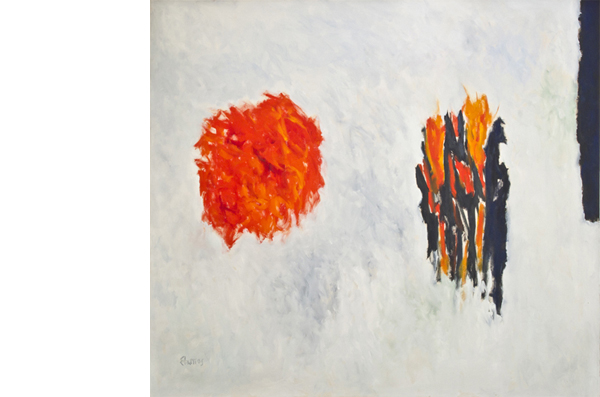
Theodoros Stamos,
Courtesy Graham Gallery.
But I had known his work since college [Yale, BA, 1983], where I had encountered it in my senior year in a seminar about abstract expressionism taught by Professor Ann Gibson.
Gibson introduced Baziotes, Gottlieb and Stamos as a branch of abstract expressionism working in a pictographic, image-specific manner—all doing these kind of Jungian essential archetypes. They represent the bridge from European surrealism, how that modernist ideal of depicting unconscious experience becomes the DNA that makes American post-war abstract expressionism possible.
GC It seems like they’re kind of the bench-warmers for the others – I know that Stamos was the youngest of the group.
JZ Well, early on, all of these guys are doing some kind of specific imagery, whether it’s representational or quasi-abstract, before they enter into their “high style.” Look at early Rothko and Pollock in this regard.
But it was really Gottlieb, with his kind of hieroglyphs, that is saying: This is the representation of the shared unconscious. That there is a specific image inventory of this neo-primitive human soul to be culled from the shared well of collective consciousness.
The funny thing is, each of these abstract expressionists develop that idea toward something that becomes strongly a signature style. It becomes like superstar branding.
GCThis Upper East Side New York gallery space, it feels like it’s filled with this particular kind of history, and I think both of us have this regard for the history of painting, specifically, New York School.
JZ For our generation, our first romance with painting is abstract expressionism; this cast of characters. So even if you don’t get involved with abstraction, that remains the core mythology of post-war American art, out of which everything else comes. Even pop art and minimalism both react specifically to abstract expressionism.
The other side of it is the story of these 57th Street galleries in the 1950s and 1960s. Here, Stamos is notorious, because after Rothko took his own life, he was involved with this scandal about Marlborough Gallery’s mishandling of the Rothko estate with regard to the artist’s children. That was Stamos’ fall-from-grace [he was a co-executor of the Rothko estate]. And it’s all intertwined in the gallery politics of that era.
“Baziotes, Gottlieb and Stamos…[t]hey represent the bridge from European surrealism, how that modernist ideal of depicting unconscious experience becomes the DNA that makes American post-war abstract expressionism possible.”
GC Yes, so when we visit these uptown galleries, that narrative is always embedded in what we’re looking at.
JZ I try to reference that aspect of it in these new word drawings that are included. They are filled with specific references: names, dates, titles, places.
GC What about the archival photographs that you included?
JZI re-photographed a few specific canonical pictures to allude to this story of Rothko and Stamos [including a photograph of Stamos’ Long Island house and studio, designed by Tony Smith].
Rothko and Stamos were said to have had lunch together every day and were very close during Rothko’s lifetime.
GC That’s the kind of lore and history that I love to hear about. And I think that’s just evident when you walk in the gallery, and you see your work in that gallery, especially with the Stamos paintings up.
JZ Absolutely. I think that’s one half of it. Approaching how we create these romantic mythologies with these artists.
But the other half is: What was it that launched our own painting out of the issues of abstract expressionism? For me, it always means making paintings that are event-driven, something where you’re looking for an image that will emerge out of the painting process itself. Also, materiality. Or moving things into large scale. So all of those are specific painting issues carrying directly over.
“What was it that launched our own painting out of the issues of abstract expressionism? For me, it always means making paintings that are event-driven, something where you’re looking for an image that will emerge out of the painting process itself.”
GC What about the way you hung the show, with the paintings next to each other?
JZ The typical way to do it would be you have a room of his paintings and you have a room of my paintings—and then people could talk about the common issues. But this was more like, what happens if you actually go so far as to try to make paintings that I wouldn’t otherwise make unless I was given this “assignment” of Stamos?
For me, that was the freedom of the project. What made the paintings finally take off was the unexpectedness of the suggestion. And whether I would “go there,” take it there. I initially said that I wouldn’t, but then it became much more interesting to me as a kind of post-appropriative way of working.
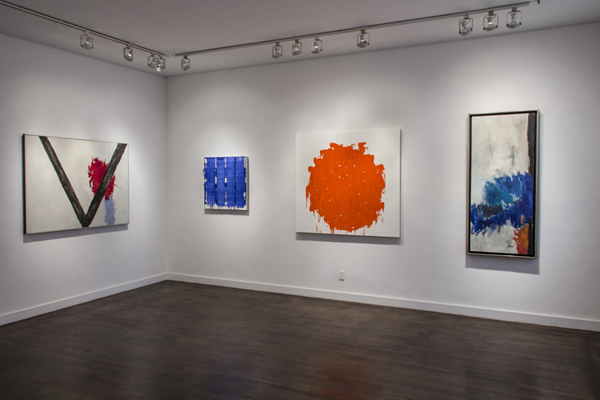
Installation,
GC What did you take from Stamos specifically?
JZI identified what I came to call these four “motifs,” to use a traditional painting term. One was this kind of canyon, or column. One was the low sun, which you constantly encounter in these Stamos paintings. The other was sea. And another was sky.
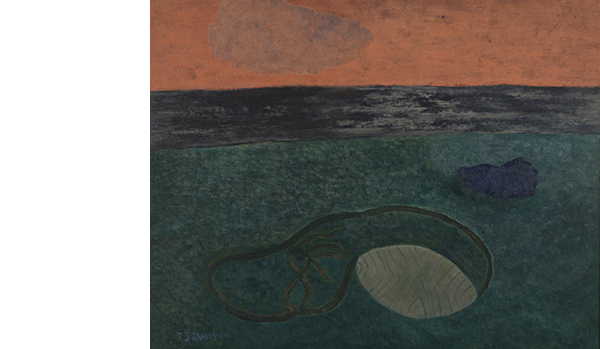
Theodoros Stamos,
Always in Stamos, there are these kind of primordial landscape elements that also refer to his Greek heritage in this kind of mythological heroical way. Particularly the sun, which, in Stamos’ case, is kind of a thicket of gestural brushstroke. It’s about displaying this urgency of event as you apply paint. But then he returns it to this very traditional iconographic image.
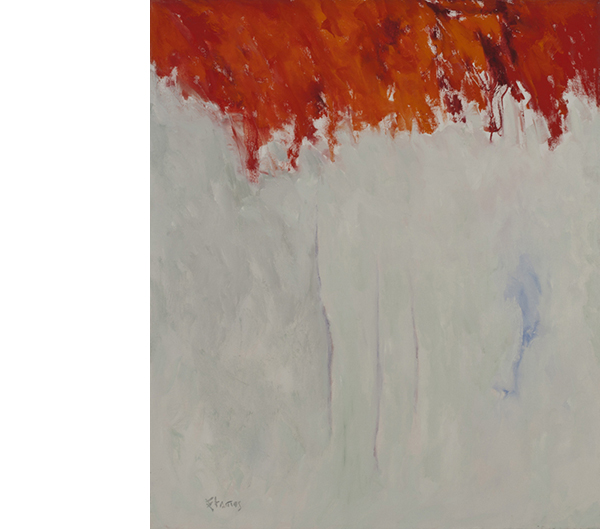
Theodoros Stamos,
GC What about your sun paintings?
JZAs soon as I made my first big sun painting, I thought about how when you’re kid you draw that circle at the top of every piece of paper that you’re going to draw on, you know, the “big sun,” and that makes the picture become the picture. That’s the way a child imagines a pictorial construct.
So, for me, not only was it the first time that I painted a circle, it’s something where you take the terms of your own painting and say: I’ve spent so much time being non-objective, material, procedural—relating to monochrome painting. Always having this tension between something being literal and pictorial. And, instead, really push the viewer toward this pictorial reading. I’m also taking these titles: Sea, Sun, Sky, The Cliff. And you’re asking the viewer to see the paintings in those terms. Suddenly it completely subverts what I’ve been doing along.
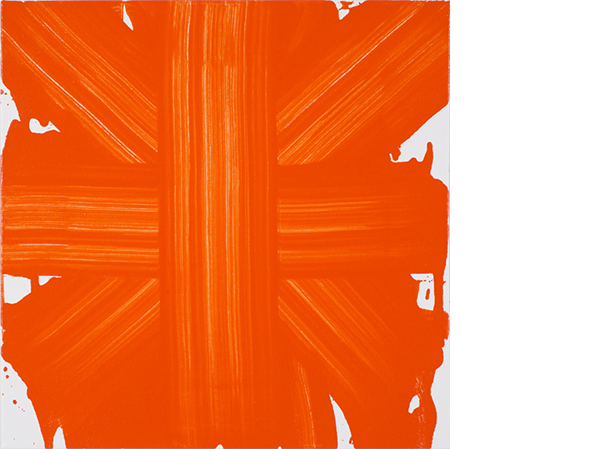
John Zinsser,
Courtesy Graham Gallery.
GC The great thing to see in the show was where you took his language of figure and ground and began to use that. Whether it’s a landscape reference or some other form, sun, maybe. I thought it was a great move. A great way to engage with his work. And a great way to push yourself.
He’s got an interesting way of handling figure and ground. It’s not all that clear in his work whether he wants to go overall painting or figure/ground. The ground is equally modulated as whatever kind of figure or shape happens in it. It’s a curious kind of push-and-pull.
JZ Yeah, he uses a lot of white space. So even though he inflects that space, as you say, it helped me to make these objective drawing-like paintings, because I could use white as a background color and then I could make them very pictographic.
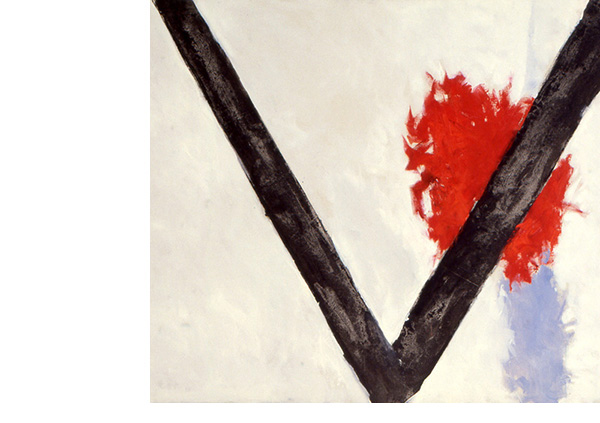
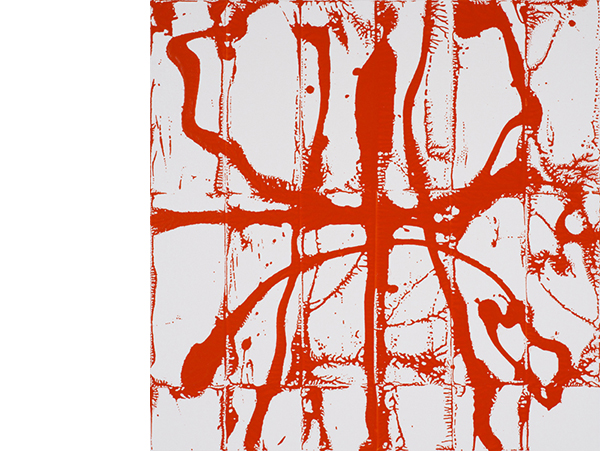
Top: Theodoros Stamos,
Bottom: John Zinsser,
Courtesy Graham Gallery.
In the case of Stamos, it’s much more overtly post-impressionist atmospheric space, because of the brush inflection. It’s the same tendency that you find in these large Clyfford Still canyon paintings. And you later find in Morris Louis, where he’s pouring paint across unprimed canvas, then that unprimed canvas begins to fulfill the same role of charged atmospheric space. The eye makes that illusionist pictorial quality happen.
GC Do you expect viewers to bring these references?
JZ I think people in their mind half know what a Stamos painting looks like –and they bring that elusive kind of index from another time—it’s like looking at a black-and-white reproduction in Irving Sandler’s Triumph of American Painting. You see something through the window of its pre-existing context. It’s often from a reproduction that references historical period or a group of shared beliefs.
GC So what is the more theoretical aspect of it?
JZ For me, it’s a question of action: How do you “rupture” something out of one context and move it into another?
Even in my own case, once we hung the paintings, there were these direct relationships, where you could move from one painting into another, from one of his into one of mine. We hung them next to each other. Instead of in separate rooms. And one kind of transforms the way that you see the other.
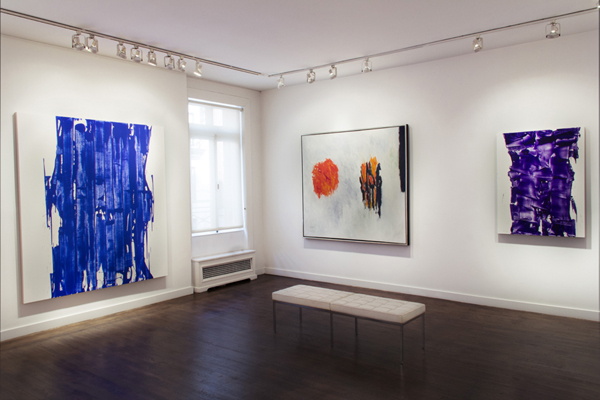
Installation,
But I wasn’t looking at the specific paintings that were going to be in the show when I painted my paintings. I had more of my own idea of what a Stamos painting looked like. I mean I had looked at catalogues and monographs and so forth. But it was more an imagined idea of what they looked like.
So it was surprising that when they actually came together, they did have these very specific resonating compositional and color relationships. Which is great. It really made it much more a present-tense open thought-inquiry that makes you re-see Stamos in a surprising way. I hope.
“For me, it’s a question of action: How do you “rupture” something out of one context and move it into another?”
GC How much of this is specific to the way our generation defines things?
JZ I think it has a lot to do with the particular time of when we got out of college, the 1980s, and were first looking at art seriously. One of the big movements at that time is appropriation. Specifically, Sherrie Levine, Mike Bidlo, Richard Prince. The radicality of it still belonged to the trajectory of the modernist avant-garde—now couched as post-modernism. The beauty of it is that you are displacing something by stealing its context. And by reassigning its authorship to yourself.
These artists are beginning to deal with issues that have to do with originality and the loss of originality—and the complete rise of photographic culture as the central reference in image-making.
But now, 30 years later, I think you’re seeing a group of artists that just think of appropriation as a standard part of artistic practice. It’s not avant-garde. Rather, it’s a way to get at what is personal in yourself.
GC How do you mean personal?
JZ I find that the irony of me doing this particular show is that the work is actually more personal. As a result of having taken somebody else’s form and run with it. They are more like my childhood drawings. Or they are more pictographic. They are more about a shared lexicon of how you see form. In terms of how form relates to the mind, both representationally and abstractly.
John Zinsser,
Courtesy Graham Gallery.
That’s something that we all try to get away from after abstract expressionism. I was interested in monochrome painting — Joseph Marioni, Marcia Hafif — because they made the painting a form in itself. You are able to see the painting as a painting. For me, that’s the great achievement abstraction.
GC So what’s changed?
JZ Those definitions, or inquiries, or relevancies, are more true to that generation than they are to me. At some point I have to say: What are we doing now? It’s all about how to respond to this vast repertoire of 20th century art in 21st century terms.
In particular, you’re playing to this new viewer-base that’s becoming more and more sophisticated in terms of these kinds of mental cross-image associations. I think that’s the gamesmanship of a lot of art right now. People see so many more images thanks to digital proliferation and are able to construct this meta-quotational structure around everything.
GC Did you read David Salle’s take on the The Forever Now show at MoMA? That’s something that he referenced, I think specifically, with regard to Mary Weatherford; about her embrace of Morris Louis, the pour painting—and appropriation. I thought it was an interesting take. That show’s taken a lot of heat. But he seemed to be pretty positive about the whole thing.
JZ David Salle is the kind of artist, when his work came along, who defined the term “zeitgeist.” It described the spirit of the times.
I think a lot of people were looking to the The Forever Now for that. It was curator Laura Hoptman’s claim that it was “atemporal” that got people’s hackles up. Of course people are looking for a show of abstraction to describe our time somehow.
People have asked me about Mary Weatherford in particular. Because we began working on similar issues in our work around the same time. And we’re friends. I see her as somebody who, without directly appropriating, is using the power of the signifiers that inform her work. Viewers bring those pre-associations to looking at her work. You might see Morris Louis, somebody else might see something else.
Again, in her case, it is what has enabled her work to become more personal rather than less personal. It’s more autobiographical. It has to do with how you learn about painting through seeing painting. As opposed to just making painting and conceptualizing painting.
GC Didn’t you recently go see Weatherford give a talk at MoMA?
JZ Yes. It was great. She was in dialogue with Katy Siegel. Most of what Mary talked about was her childhood—and her experiences in New York when she was a younger artist. She really describes how her work’s iconography was formed as a set of specific episodes and intellectual “light bulb” moments. And how you can retroactively find those once you are working inside of a form. It reveals those things.
GC So, in your show, the sun painting came first?
JZ The first one that I did was one of the cliff ones. That’s when I realized that I could sort of do it within my own painting language. Really have it be true to the way I already conceive of and execute paintings.
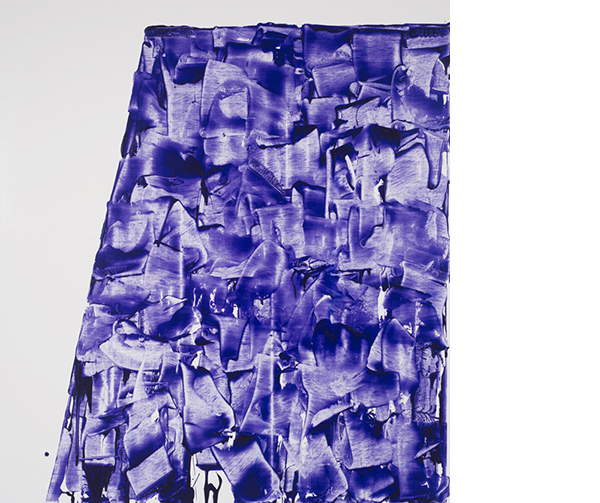
John Zinsser,
And then, when I did the sun, I really liked the image. I liked the way I was able to paint it. In general, the paintings were much more planned and drawn out ahead of time than I usually work.
GC I would have guessed the opposite.
JZ With the sun painting, I wanted it to have these kind of openings through to the backfield, this kind of thicket of brushstrokes.
Most of them were drawn on paper first, pretty specifically as images and executed with some degree of faithfulness to that.
Another kind of important part of the show is that it is somewhat irreverent and funny, in an affectionate way, I hope. You know, you can do something that’s much more than just about how you respect an artist. This is sort of how not to respect an artist. I don’t know how Stamos would react to it. Maybe he would like it, actually. I hope so.
GC How would you like the public to see it?
JZ It’s not trying to be devotional to an a priori philosophy or a form. It’s trying to get something out of it that relates to the here-and-now. To get back to the The Forever Now, the curator, Laura Hoptman, one of the things that she writes about in her essay, she says abstraction has become a representational painting style – they’re representations of abstractions.
So I do think that that’s different from when the abstract expressionists moved away from representation into pure abstraction. That was the initial “triumph,” that’s Rothko. When Rothko was able to remove the figure from the ground—and just be in the field of color. Or, you, the viewer, become the figure.
If we take that notion of figure forward, the figure that I am in this particular enterprise is the narrator. It’s like a literary construct. You’re telling the story in a certain way. And trying to move it away from the past-tense, which is the usual way that stories get told by galleries and museums.
So what happens when you move a historical figure into the present-tense? There’s an unexpected immediacy—and it changes the nature of looking.
[portfolio_slideshow id=8160 exclude=”8242,8235,8222,8211,8209,8204,8203,8201,8199,8196,8193,8186,8185,8177″]
Born in Manhattan in 1961, John Zinsser received a BA in art history at Yale University in 1983. He co-founded Journal of Contemporary Art in 1987. He is a longstanding lecturer at New School University in New York. As an artist, he has had over 30 solo exhibitions in the US and Europe. He is the subject of a recent monograph, John Zinsser: New York Paintings, published by kunstgaleriebonn.
Born in Long Beach, Long Island, painter Guy C. Corriero got his BFA from School of Visual Arts in 1985 and his MFA, also from SVA, in 1989. He recently had a show at Junior Projects in Manhattan’s Lower East Side Gallery district. In Switzerland, he is represented by Basel’s Mitart Gallery.
Related Links:
Visit John Zinsser’s website at johnzinsser.com.
Read Art in America’s review of Guy C. Corriero at Junior Projects.
Subscribe to Tilted Arc
If you like this story, please consider subscribing. We are sticklers for privacy.
We will never sell or share your e-mail address.

